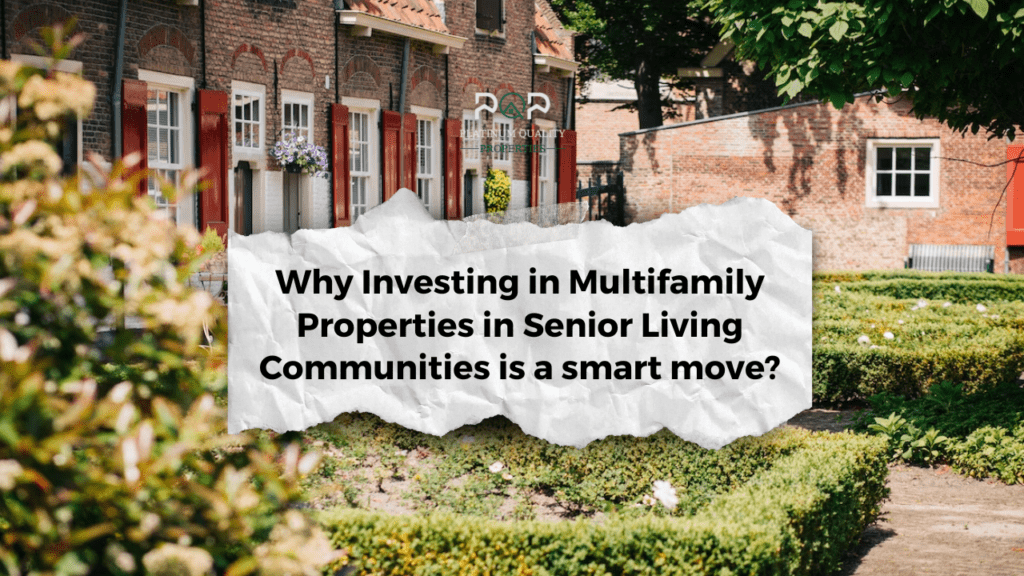Multifamily properties in senior living communities are becoming an increasingly popular investment choice for many investors. These types of properties offer a unique combination of high demand and consistent cash flow, making them a smart investment choice for those looking for long-term returns. In this blog post, we will discuss why investing in multifamily properties in senior living communities is a smart move, the demographics of aging baby boomers, advantages of investing in these properties, potential challenges and risks, and how to get started in this type of investment.
DEMOGRAPHICS OF AGING BABY BOOMERS
The baby boomer generation, born between 1946 and 1964, is the largest demographic group in the United States. As this generation ages, the need for senior living communities is increasing. According to the U.S. Census Bureau, by 2030, all baby boomers will be over the age of 65, and the number of seniors in the U.S. is projected to reach 73 million. This means that the demand for senior living communities is expected to continue to rise in the coming years.
Advantages of Investing in Multifamily Properties in Senior Living Communities
There are many advantages to investing in multifamily properties in senior living communities.
Consistent cash flow and steady rental income
Investing in multifamily properties in senior living communities can provide consistent cash flow and steady rental income. Seniors are often on a fixed income and are reliable tenants, making it easier to forecast rental income and cash flow.
Lower tenant turnover and longer lease terms
Senior tenants typically stay in their units for longer periods than younger tenants, resulting in lower tenant turnover and more stable occupancy rates. This reduces the need for marketing and tenant turnover costs and results in more predictable rental income.
Higher demand and lower vacancy rates
Senior living communities are experiencing a surge in demand, leading to lower vacancy rates in properties located in these communities. With increasing demand, there is also an opportunity to increase rent prices over time.
Opportunities for value-add investments and property improvements
Multifamily properties in senior living communities often provide opportunities for value-add investments and property improvements. For example, properties with outdated amenities or units in need of renovation can be improved to attract more senior tenants and increase rental income.
POTENTIAL CHALLENGES AND RISKS
As with any investment, there are also potential challenges and risks associated with investing in multifamily properties in senior living communities.
Regulatory requirements and compliance issues
There are a number of regulatory requirements and compliance issues that need to be taken into consideration when investing in senior living communities. Investors must comply with state and federal laws and regulations relating to senior housing and ensure that their properties meet all necessary safety and health standards.
Property maintenance and management challenges
Multifamily properties in senior living communities require ongoing maintenance and management to keep them in good condition and ensure that the needs of senior tenants are met. This can be time-consuming and require specialized expertise in senior housing management.
Economic and market risks
Like any investment, multifamily properties in senior living communities are subject to economic and market risks. Economic downturns or market fluctuations can impact rental income and occupancy rates, which can have a negative impact on the value of the investment.
HOW TO GET STARTED IN MULTIFAMILY PROPERTY INVESTMENT IN SENIOR LIVING COMMUNITIES
If you are interested in investing in multifamily properties in senior living communities, there are a few steps you can take to get started.
Steps to take before investing
Before investing, it is important to conduct thorough research on senior living communities in your area and identify properties that align with your investment goals.
Factors to consider when choosing a property
When choosing a property, it is important to consider factors such as location, property condition, and potential rental income. You may also want to consider the types of amenities that are important to senior tenants, such as wheelchair accessibility or on-site healthcare services.
Strategies for financing and managing the investment
There are a variety of financing options available for investing in multifamily properties, including traditional bank loans, private financing, and partnerships. Once you have secured financing, it is important to have a solid plan in place for managing the property, including hiring a property management team with experience in senior housing.
Investing in multifamily properties in senior living communities can provide a unique combination of high demand, consistent cash flow, and opportunities for value-add investments. However, it is important to be aware of the potential challenges and risks associated with this type of investment, including regulatory requirements, property maintenance and management challenges, and economic and market risks. By conducting thorough research, considering important factors when choosing a property, and having a solid plan in place for financing and managing the investment, investors can make a smart move by investing in multifamily properties in senior living communities.

